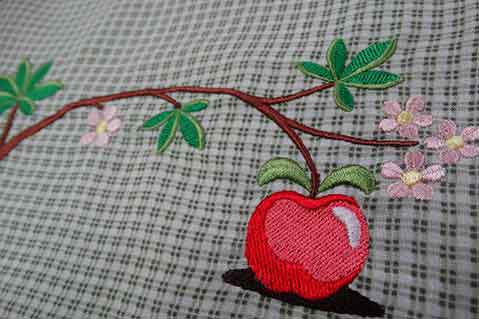Strategy June 28, 2017
Stock up on the Right Embroidery Thread

It’s easy to be overwhelmed the array of embroidery thread colors and types on the market. Use these questions as a guide to stock your shop.
Q: What is the nature of the end products you embroider?
A: Do you focus on school athletics, local restaurants, a high-end boutique or business branding? Choosing rayon or polyester thread is dependent on the types of items you embroider. Rayon is an easy-running thread that is soft enough to lay into the most complicated design. It will hold up to hot wash water. However, if there’s a chance your finished products will be thrown into a wash water with harsh bleach, or if you work with a local college swim team, say, and regularly decorate swimsuits that will be exposed to chlorine, choose 100% polyester 40-weight embroidery thread. Once you’ve chosen rayon or polyester, stick with it, rather than asking your machine to switch back and forth.
Q: How much competition for embroidery business is there in your location?
A: If you’re the only game in town, running general purpose 40-weight embroidery thread will serve you well for some time. If, on the other hand, you are one more embroidery shop in town, invest in specialty threads to set you apart from the pack.
Thin 60-weight thread (available in rayon and polyester) is ideal for small lettering and fine details. When it comes to the detail required in some corporate logos, and the small lettering slogans often require, you will set yourself apart with the clarity achieved through the use of 60-weight.
Being able to drop a metallic thread, like a 50- or 40-weight for smooth run-ability, into a stock design will further set your work apart. Use matte finish threads for shading and subtle tone on tone, glow-in-the-dark thread for theater costumes or children’s wear, and fire-resistant thread when safety is an issue. Mastering specialty threads enables you to offer customers a look they may not be able to find elsewhere, and the threads will prove to be problem solvers down the road.
Q: What are your bottom-line concerns?
A: Being cost-conscious and watching unnecessary spending is mandatory. However, when it comes to stocking thread, paying pennies more for a top-quality thread will save dollars in production time. A typical 5,500-yard cone of embroidery thread yields approximately 1 million stitches, while the average 1,100-yard spool will produce 250,000. Having your machine run flawlessly through your jobs, rather than dealing with thread breaks – stopping the machine, re-threading needles, re-positioning and beginning again – is a better business choice than opting for the cheapest embroidery thread on the market.
Q: Should color be controlled or celebrated?
A: In choosing thread colors, think about how much control you’d like to maintain. Are you an artistic type who wants to be surrounded by one of every color? If yes, invest in the smaller put-ups of 1,100 yards, turning to large cones for black, white and some of your basic colors. Or do you want to control your inventory, so that customers have one or two purples to choose from, instead of 16? In that case, you may want to choose basic colors, doubling up on the cones and spools, so that you can display spools of the specific colors you’ve chosen and run the large cones.
Q: How environmentally concerned are your customers?
A: It’s a question that finds folks either one way or the other, but rarely on the fence. If you offer apparel made from natural fibers and wish to continue the theme, choose 40-weight rayon. Rayon embroidery thread is made from wood pulp, rather than petroleum, like polyester. Rayon colors are lustrous, as opposed to shiny – a subtle distinction, but one that fine-art embroiderers are drawn to.
***
Alice Wolf is the manager of education and publications at Madeira USA. An industry writer, she produces several webinars each year, encouraging embroiderers to try new things and succeed within the decorated-apparel market. Contact her at awolf@madeirausa.com; 800 225-3001, ext. 107.
